How UK Broadband Infrastructure Works (Fibre, 5G, Wireless)
Broadband infrastructure is the foundation of internet connectivity across the UK, enabling access for homes, businesses, and public institutions.
It comprises a vast network of fibre, copper, and co-axial cables, alongside wireless systems and satellite links, all supported by data centres, exchanges, cabinets, antennas, and more.
This article explores how the core, distribution and wireless infrastructure fit together to make the semi-unified UK broadband network.
Contents:
- What is broadband infrastructure?
- Core network
- Distribution and access network
- Wireless broadband infrastructure
- Challenges in the broadband rollout
- Government plans and public investment
- FAQs
What is broadband infrastructure?
Broadband infrastructure is the physical and technological base layer of UK internet connectivity.
It consists of an extensive network of physical fibre, copper and co-axial cables, supported by thousands of street cabinets, exchanges, data centres, antennas and satellites.
Despite being owned and operated by a variety of companies, internet service providers use this foundation infrastructure to provide their internet services to homes, businesses and institutions across the UK.
Ofcom is the UK regulator in charge of ensuring this vast internet multi-stakeholder infrastructure remains accessible and fair.
The UK’s broadband infrastructure can be divided into three key segments:
- Core network. The high capacity, low latency infrastructure that carries data across long distances, like internet motorways.
- Distribution and access network. The network of cables and physical infrastructure that connects end-users to the core network, like local road systems.
- Wireless network: The mobile and satellite systems that provide connectivity through the air, usually for remote or mobile settings.
The following diagram illustrates how these three key segments fit in to provide broadband in the UK:
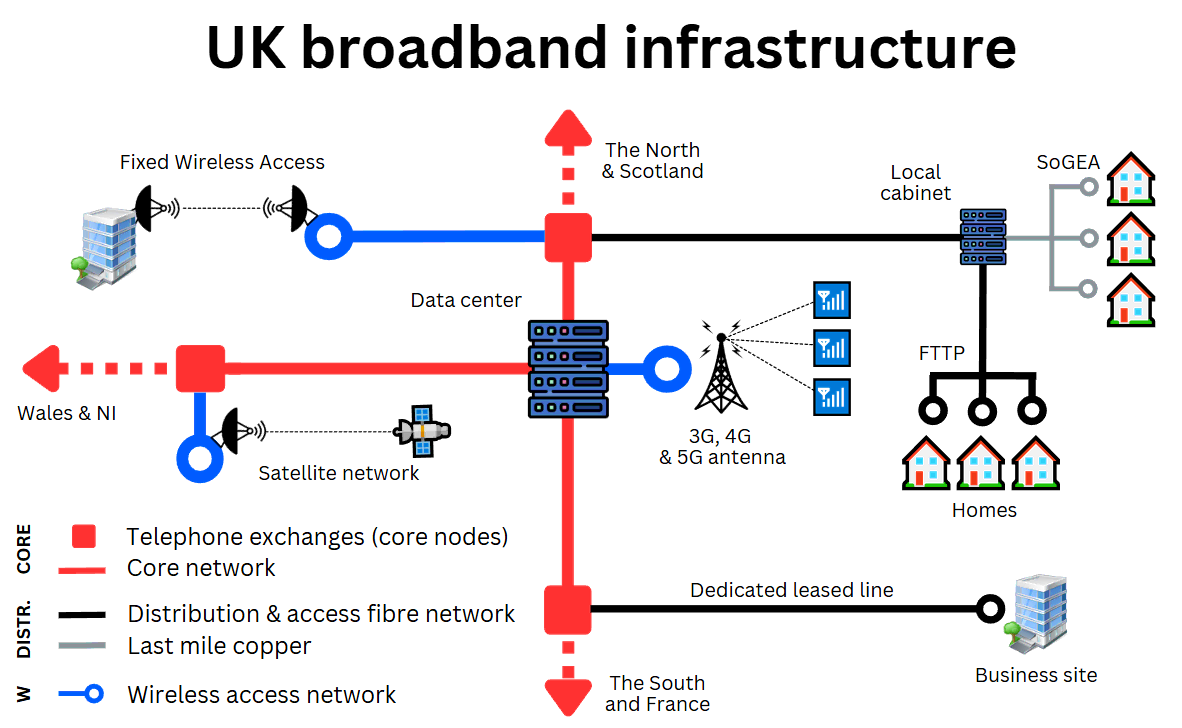
Core network
The core network is the foundation of internet infrastructure in the UK, moving data at high-speeds across the country and abroad, much like the UK electricity transmission network.
Here are its key components:
- Core network nodes and data centers: Large facilities near major cities where internet traffic is routed and switched. These act as control hubs, handling data flows measured in terabits per second.
- Telephone exchanges: Once used for landlines, these buildings now house broadband equipment and link local infrastructure to national fibre routes. These hubs are owned by Openreach but shared by multiple providers.
- Backhaul fibre networks: High capacity MPLS-enabled fibre cables that connect exchanges to data centres and international gateways. These long-distance links form the main routes of the internet in the UK.
- Internet Exchange Points (IXPs): Data centers where broadband providers exchange traffic between their networks (e.g. BT, Virgin Media). Often housed alongside core network nodes.
- Points of Presence (PoPs): Connection points where individual business broadband providers access the wider network. Found in exchanges, data centres and local cabinets.
Distribution and access network
The distribution and access network connects individual premises to the core network’s telephone exchanges through local fibre, copper and co-axial lines and hubs.
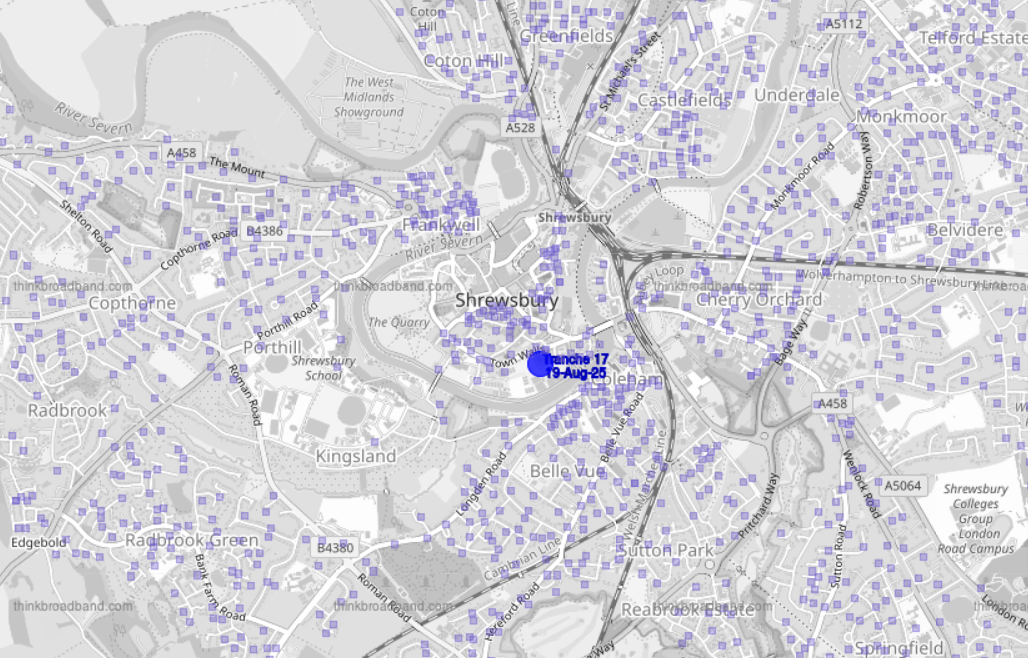
Distribution and access hubs
These hubs are physical aggregation points where subscriber lines are aggregated. Ownership varies between Openreach and independent Altnets, depending on the network operator:
- Street cabinets (For EFM/SoGEA): Green roadside boxes that connect premises to the fibre backhaul. Contain DSLAMs (Digital Subscriber Lines Access Multiplexer) that enable use of existing copper lines for the ‘last mile’ segment.
- Fibre distribution hubs (For FTTP): Underground or street-level aggregation points that split fibre to serve local areas with full fibre broadband connections. Each hub can support up to 64 homes or 20 small businesses for contended broadband connections.
- Co-axial network cabinets (For cable broadband): Cabinets housing amplifiers and splitters that distribute signal via co-axial cable from nearby fibre nodes to the premises. Each cabinet can serve 200+ subscribers.
- Leased line relay nodes (For leased lines or Business Ethernet): Compact cabinets with dedicated equipment for uncontended fibre connections. Used where direct access from the exchange is impractical, ensuring business-grade performance.
Distribution and access lines
These are the copper, co-axial and fibre optic cables that extend from distribution hubs to individual premises. They function like the capillaries of the broadband network, delivering the final connection to the end user.
- Local fibre optic networks: High speed fibre links that join the core network with local street cabinets and fibre distribution hubs. Much like A-roads, they form the intermediate routes between national infrastructure and local access.
- Copper cables (twisted pair): Legacy telephone wiring is still used in the final segment of copper based broadband and traditional voice services. Most common in areas not yet upgraded to full fibre.
- Co-axial cable networks: Used in hybrid fibre and co-axial (HFC) systems, such as cable broadband from Virgin Media. These lines carry signals from coax cabinets to subscriber premises.
Core, distribution and access infrastructure stakeholders
The UK’s fixed line broadband infrastructure is operated by a mix of organisations, primarily Openreach and an increasing number of independent providers known as Altnets.
Openreach vs Altnets
Openreach was originally part of the state-owned BT Group and inherited control of the national copper network and most street-level broadband assets.
Since the deregulation of the telecom sector in the 1990s, independent networks (known as “altnets”) have emerged to build their infrastructure. These networks often target rural, suburban or newly developed areas where Openreach has been slower to deploy fibre.
Altnets build both core and access infrastructure, including long-distance fibre routes, local distribution hubs and full fibre lines to premises.
Unlike Openreach, they operate fibre-only networks and do not rely on the legacy copper system.
Stakeholders
The following table summarises the key stakeholders and operators of the UK’s broadband core, distribution and access infrastructure:
| Component | Owner(s) | Operator(s) |
|---|---|---|
| Core network nodes & data centres | Telehouse, Equinix, Openreach, CityFibre | BT, Vodafone, Virgin Media O2, altnet providers |
| Telephone exchanges | Openreach | Openreach (LLU access for TalkTalk, Sky, etc.) |
| Backhaul fibre networks | Openreach, Vodafone, Virgin Media, Zayo | Same as owners + altnet providers like CityFibre |
| Internet Exchange Points (IXPs) | Neutral organisations (e.g. LINX, LONAP) | Same as owner |
| Points of Presence (PoPs) | Each individual broadband provider | Same as owner |
Fixed line broadband services
Fixed line broadband services operate as an overlay on top of targeted parts of the distribution and access network.
For example, the map below shows the geographical extent of three different broadband services, each offered by a different business broadband provider.
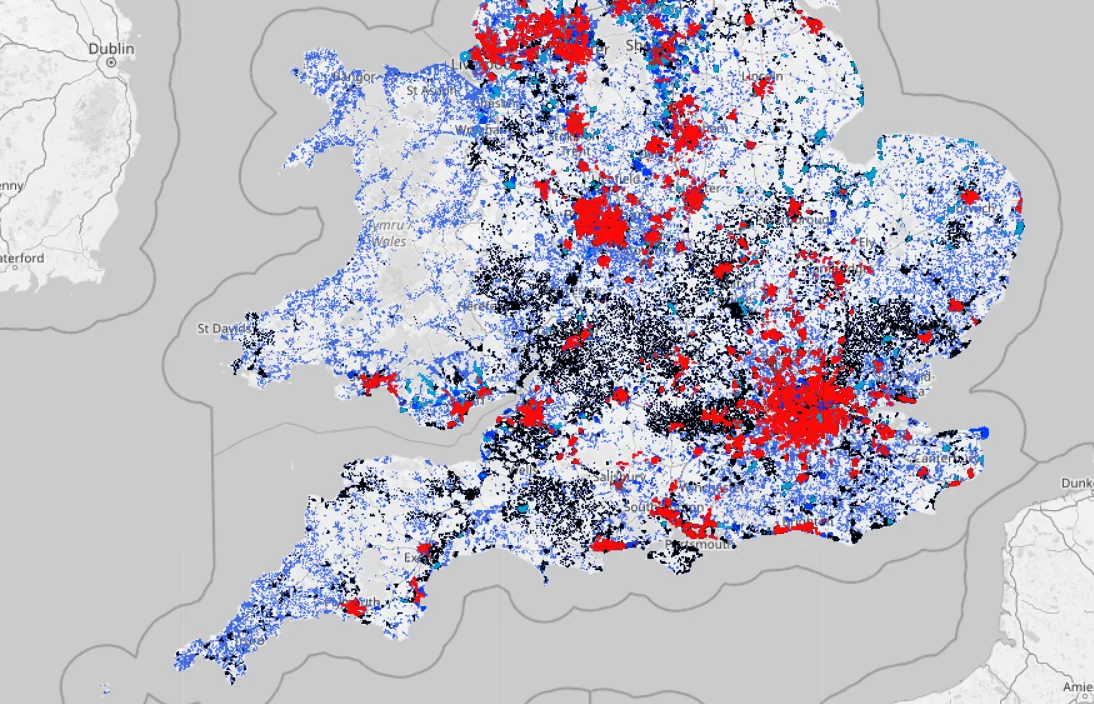
Below is an overview of the main service types, ordered by performance:
Leased line broadband
Relies on: Dedicated fibre lines and relay nodes linking premises directly to the exchange.
This is the highest performing broadband service, used exclusively by businesses. It provides a direct, uncontended fibre line from the core network to the premises, avoiding the shared local infrastructure where congestion typically occurs.
There are tens of leased line providers in the UK, including:
Full fibre broadband
Relies on: Local fibre optic network and fibre distribution hubs.
This is the second highest performing broadband type, available to both homes and businesses. It uses full fibre throughout, but bandwidth is shared across multiple premises, so performance may vary during peak times due to contention.
It is offered by the majority of business broadband providers, such as:
Virgin Media’s cable broadband
Relies on: Co-axial network cabinets and lines.
Virgin Media operates the UK’s largest co-axial cable network, originally built for cable TV.
This infrastructure is still used to deliver broadband, offering speeds up to 1 Gbps. However, it typically has higher latency, greater contention and lower reliability compared to full fibre.
Availability is limited to specific urban areas and the service is offered exclusively by Virgin Media business broadband.
SoGEA broadband (FTTC without the landline)
Relies on: Fibre to the street cabinets, then copper for the ‘last mile’.
SoGEA broadband is a version of Fibre to the Cabinet (FTTC) that operates without a traditional landline. It has become the standard replacement ahead of the upcoming PSTN switch-off.
While widely available, performance is limited due to its continued reliance on copper for the final connection.
It is offered by all major business broadband providers.
ADSL
Relies on: Copper cables and local street cabinets only.
ADSL is a legacy broadband service, now used only where no other fixed line options are available.
It is most common in rural and underserved areas, and offers limited performance due to its full reliance on ageing copper infrastructure.
Offered by a small number of providers, such as BT business broadband.
Fixed line Ethernet services
The UK’s fixed line broadband infrastructure also supports dedicated Business Ethernet services used exclusively to interconnect multiple business sites.
These are typically delivered in two main ways:
Direct Ethernet access
Relies on: Leased line broadband infrastructure (local fibre and relays)
Used to connect multiple business locations with dedicated, high-performance links. When linking just two sites, it is often referred to as a point-to-point leased line.
Ethernet-in-the-First-Mile (EFM)
Relies on: SoGEA based infrastructure (copper and fibre via street cabinets)
EFM provides dedicated connectivity to business sites in areas where full fibre is not yet available, so relies on copper. It is commonly used for rural or hard-to-reach locations.
EFM is offered by providers, including Zen business broadband.
Wireless broadband infrastructure
Wireless broadband transmits internet data using radio waves rather than physical cables.
It includes the hardware, antenna systems, spectrum and transmission paths that support mobile, satellite and fixed wireless connectivity.
Mobile broadband infrastructure
This infrastructure supports mobile network delivery via a nationwide mesh of antenna sites and fibre-linked nodes. It includes:
- Macro cell towers: Tall ground-based or rooftop towers equipped with directional panel antennas. These form the foundation of 2G, 3G, 4G, and 5G coverage across the UK.
- Small cells and microcells: Low-power, short-range radio units installed on lampposts, building walls, or bus shelters in urban areas to improve density. Vital for 4G capacity and the 5G rollout.
- Antenna hardware and MIMO systems: Antennas vary by generation, 5G infrastructure often includes massive MIMO arrays and beamforming tech to optimise spectral efficiency.
- Radio access equipment (eNodeB, gNodeB): Located in base station cabinets at the mast site. These manage signal transmission and user handoff, forming the last wireless hop to devices.
- Spectrum allocation and frequency bands: UK mobile infrastructure operates across multiple bands. 800 – 2600 MHz for legacy and 4G LTE; 700 MHz and 3.4–3.8 GHz for 5G. Spectrum is licensed via Ofcom.
- Backhaul connectivity: Each antenna site directly links back to the core fibre network via high-speed local fibre lines and direct wireless access in remote zones. Backhaul cabinets are most often co-located at tower bases.
Mobile business broadband services
Relies on: Mobile infrastructure, including 5G, LTE and 3G networks.
Business mobile broadband can be delivered on site using a business broadband router with a SIM or eSIM, or remotely via a business dongle. It is commonly used as a backup connection for failover or network load balancing, though in areas with strong 5G coverage it can serve as a primary connection.
Mobile broadband providers include Vodafone business broadband, Three and EE.
Satellite broadband infrastructure
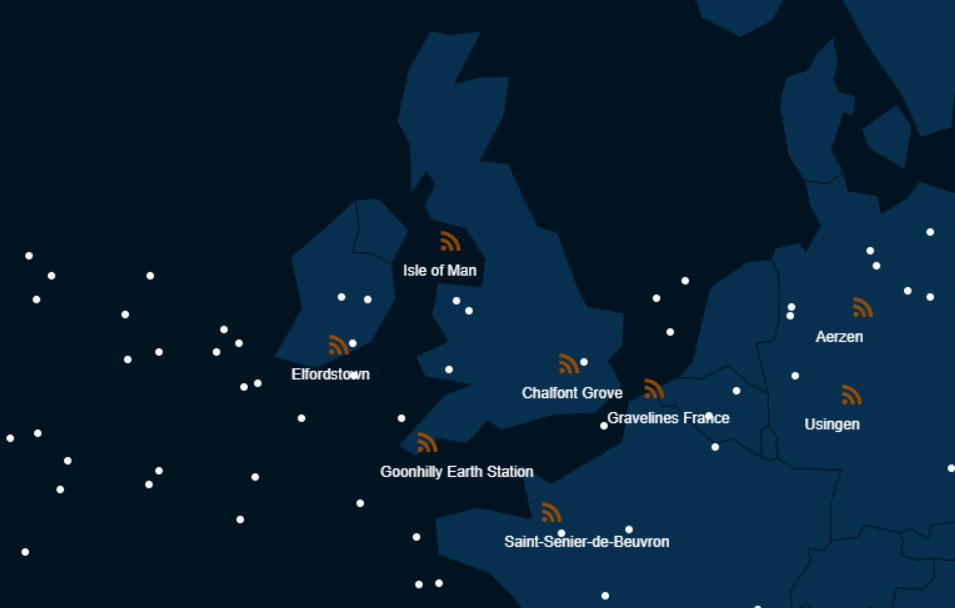
This infrastructure delivers broadband via radio signals exchanged between orbiting satellites and ground stations.
- Orbital infrastructure:
- GEO satellites (36,000 km orbit): Provide broad coverage using large beam footprints. High latency. Examples include Eutelsat and ViaSat.
- LEO constellations (500–2000 km orbit): Lower latency broadband using many satellites in coordinated mesh orbits. Requires tight synchronisation and ground network integration. Examples include Starlink and OneWeb.
- Ground station gateways: Large terrestrial antenna arrays that transmit data between satellites and the terrestrial fibre backbone. Located in remote, interference-free areas with direct fibre backhaul, such as these UK Starlink ground stations.
Satellite business broadband services
Relies on: Full stack of satellite infrastructure, including LEO and GEO satellites.
Business satellite broadband services are available across the UK, including offshore and remote areas, as long as there is a clear line of sight to the sky.
Businesses typically install on-site antenna receivers linked to routers and firewalls. It is often used in remote locations or as a backup connection.
Satellite broadband providers include Starlink, OneWeb and other managed service providers.
Fixed Wireless Access (FWA) infrastructure
FWA delivers broadband using radio signals from fixed base stations to static premises, often as an alternative to wired leased lines in rural areas, as per the map below:
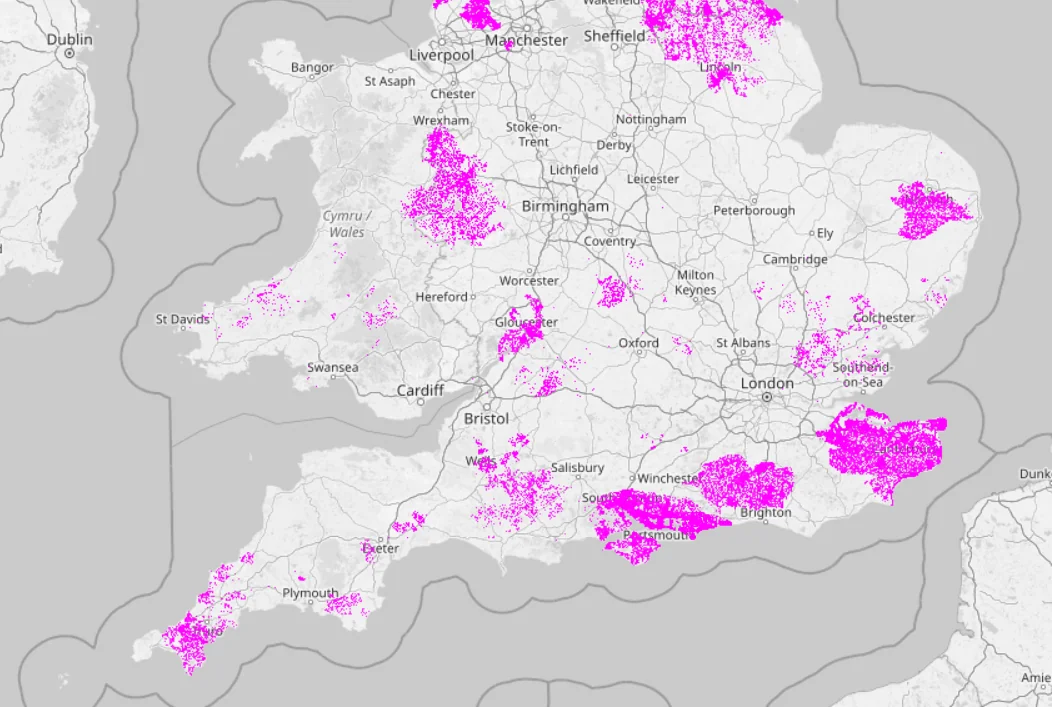
Its infrastructure includes:
- Base and relay station sites: Antennas mounted on towers, poles or rooftops. These use microwave or millimetre wave frequencies and connect to the internet backbone via fibre or radio relay.
- Spectrum and licensing: Operates in licensed bands (e.g. 10 GHz, 28 GHz) and unlicensed bands (e.g. 5.8 GHz), which affect range and performance.
- Customer premises receiver units (CPRUs): Directional antennas installed on rooftops or poles, requiring line of sight to the nearest base station.
Wireless Leased Line services
Relies on: Full FWA infrastructure stack.
Wireless leased line provides dedicated connectivity where a line of sight to a base station is available. Coverage is strongest in urban areas but can be extended to rural sites as needed.
Wireless leased line providers include M24Seven and Quickline.
Key stakeholders
The following table summarises the key stakeholders and operators of the UK’s wireless broadband infrastructure:
| Component | Owner(s) | Operator(s) |
|---|---|---|
| Mobile towers & small cells | Cellnex, Cornerstone, WIG, MNOs | EE, Vodafone, O2, Three (via sharing deals) |
| Mobile spectrum | N/A (licensed by Ofcom) | EE, Vodafone, O2, Three |
| Satellite infrastructure (LEO/GEO) | Starlink (SpaceX), OneWeb, Viasat, SES, Eutelsat | Same as owner |
| Satellite ground stations | Satellite providers or carrier-neutral data centres | Same as owner |
| Fixed Wireless Access (nodes/antennas) | Altnet providers like Quickline, Airband | Same as owner |
| FWA spectrum | N/A (licensed/unlicensed via Ofcom) | Altnet and rural wireless service providers. |
Challenges in the broadband rollout
The UK has made major strides in broadband infrastructure, with full fibre coverage expanding from just 11% of premises in 2019 to nearly 70% in 2025.
But rollout remains uneven. Rural areas still lag behind urban centres, and the UK overall trails countries like France and Spain, where fibre reaches over 90% of premises.
Here’s why:
City vs rural rollout
Full fibre upgrades target cities first, as higher population density increases return on investment.
In contrast, rural and suburban areas are often last in line due to the long distances, complex terrain, and higher per-property costs, which make infrastructure builds commercially unattractive.
Wayleaves and planning delays
Another issue in the UK is difficulty in acquiring legal permissions (wayleaves) from landowners and councils to install new fibre or wireless infrastructure.
In apartment blocks, landlords often don’t respond or allow upgrades, while councils often have planning restrictions that slow the rollout of new cabinets, poles, or masts.
Old buildings
Even when full fibre or leased lines are available, many properties remain offline due to poor internal wiring and high network installation costs within the property.
This is a particular problem in older buildings, shared business premises, and apartment blocks where internal upgrades or landlord permissions may block access altogether.
Government plans and public investment
The UK government is backing several major programmes to improve broadband infrastructure across the country, particularly for the roll out of fibre in rural and underserved areas.
This investment is essential for business competitiveness, especially as the UK continues to lag behind other developed nations in full fibre coverage.
Here are the key ones to know about:
Project Gigabit
Up to £5 billion in funding was provided for Project Gigabit to roll out gigabit-capable full fibre in rural areas where commercial providers won’t invest due to higher costs.
The roll out is delivered by Openreach and Altnet networks, whoever is best positioned in that specific area.
The map below shows the UK constituencies by Gigabit (i.e. speeds above 1Gbps) broadband availability (Green = 90% or above, Red = 50% or more):
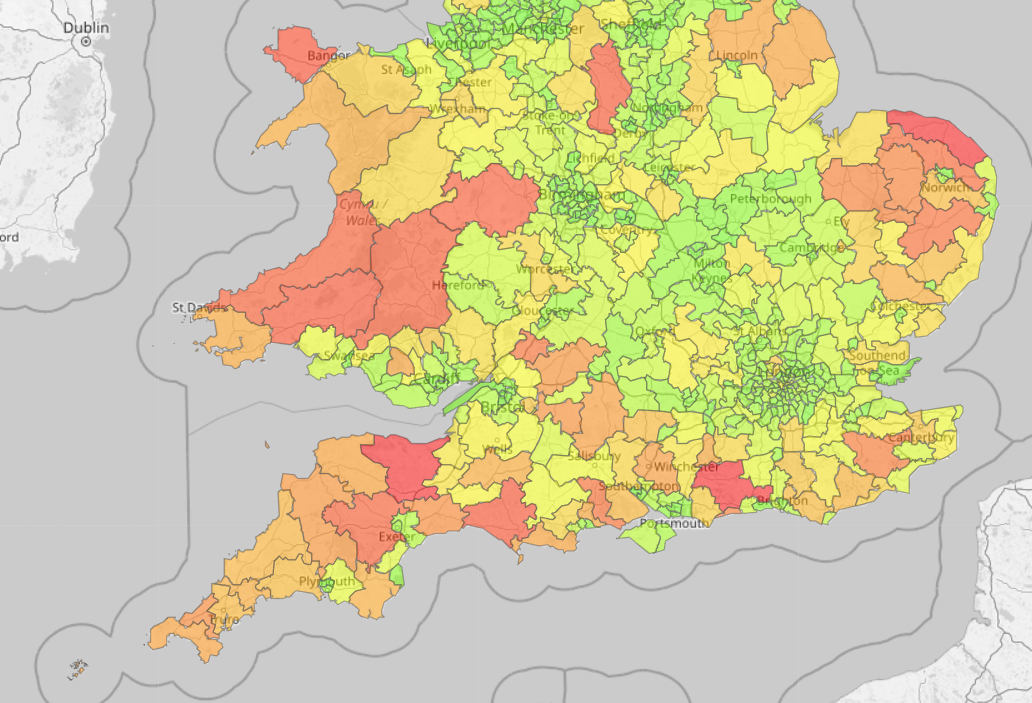
Shared Rural Network (SRN)
Joint project with mobile operators to improve 4G coverage in rural areas by upgrading and sharing mobile masts. It also directly helps support 5G and fixed wireless access (FWA) broadband.
PSTN Switch Off
Known as the PSTN Switch Off, the copper phone network is being switched off by 2027, forcing a shift to full fibre and business VoIP phone systems.
This is mostly an industry initiative aiming to speed up fibre rollout and re-direct the costs of maintaining costly legacy infrastructure into expanding the network.
OneWeb
The UK took a stake in satellite provider OneWeb in 2020 to improve connectivity in remote areas. While the UK’s share has since diluted significantly, OneWeb HQ remains in the UK and the network supports rural satellite broadband alongside providers like Starlink.
Planning and access reforms
The government has eased planning rules for street-level infrastructure and enabled access to Openreach ducts and poles, helping providers roll out fibre and 5G business broadband faster and more cheaply.
The future of broadband infrastructure
Looking beyond today’s challenges and government programmes, the UK’s broadband infrastructure is on the brink of transformation.
Wireless infrastructure is providing business-grade broadband without the need for fibre in rural areas, software is making existing fibre infrastructure even faster, and traditionally siloed networks are being unified to enable next-generation smart applications like Iot and smart cities.
Filling the gaps with satellite and mobile networks
Full fibre will remain the foundation for low latency, high speed connectivity across the country and urban areas.
But in rural and hard-to-reach areas, 5G fixed wireless access (FWA) and LEO satellite services like Starlink and OneWeb are emerging as the most viable long-term alternatives.
They’re faster to deploy, far more cost-effective in low-density regions, and increasingly capable of delivering business-grade performance.
Smarter infrastructure through software
Broadband networks are improving their performance through software upgrades.
Technologies like AI-driven diagnostics, software-defined networking (SDN), and automated capacity scaling are reshaping how infrastructure is monitored, optimised, and maintained.
In practice, this means that the physical infrastructure is becoming faster and more reliable through the use of smarter software. Performance gains are increasingly driven by algorithms, not cables.
Convergence of siloes into an integrated broadband network
Today, fibre, mobile, and satellite networks operate separately. Devices must choose between fixed line broadband, 4G, 5G, or satellite based on the services acquired.
In the future, these networks will converge into a single access layer. Devices and premises will connect seamlessly via the best available route, without users needing to manage the underlying technology.
This shift will be driven by software-defined networks, intelligent traffic management, and tighter integration between fixed, mobile, and satellite infrastructure, permitting scalable smart applications in the UK.
Complete phasing out of legacy copper
The UK’s copper network will soon be completely turned off with the PSTN Switch Off set for 2027. This means that legacy services like ADSL, FTTC and traditional business phone lines will disappear soon after.
What remains will be a fully IP-based network, primarily fibre, but supported by wireless where needed.
Broadband infrastructure – FAQs
Our business broadband experts answer commonly asked questions regarding the UK’s broadband infrastructure:
Who owns most of the UK’s broadband infrastructure?
Openreach (part of BT group) owns and maintains the majority of fixed-line broadband infrastructure. However, this dominance is waning with the rise of altnets and the growing integration of mobile and satellite networks into a unified, software-defined broadband ecosystem.
Will ADSL be phased out completely?
Almost entirely. After the PSTN switch-off scheduled for 2027, most ADSL services will be retired in favour of fibre-based digital services.
However, in areas where no alternative exists, limited ADSL support will remain for a time, until wireless or satellite alternatives become fully viable and affordable.
Is there business-only broadband infrastructure?
Yes. Dedicated leased lines are reserved exclusively for business and institutional use. This includes fibre-based and copper-based Ethernet services, any relay points dedicated to business traffic, and wireless leased line antennas.
These connections offer strong performance guarantees through Service Level Agreements (SLAs) which make them suitable for business-critical applications such as VoIP, UCaaS, cybersecurity SaaS, etc.

